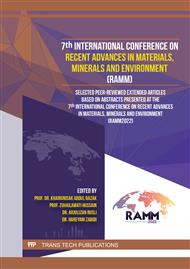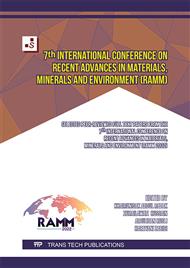[1]
S. Subedi, G. Arce, M. Hassan, N. Kumar, M. Barbato, M.T. Gutierrez-Wing, Influence of production methodology on the pozzolanic activity of sugarcane bagasse ash, MATEC Web Conf. 271 (2019) 07003.
DOI: 10.1051/matecconf/201927107003
Google Scholar
[2]
H. Zhao, W. Sun, X. Wu, B. Gao, The properties of the self-compacting concrete with fly ash and ground granulated blast furnace slag mineral admixtures, J. Clean. Prod. 95 (2015) 66–74.
DOI: 10.1016/j.jclepro.2015.02.050
Google Scholar
[3]
N.N. Zulkarnain, S.A. Farhan, Y.A. Sazali, N. Shafiq, S.H. Abd Rahman, A.I. Abd Hamid, M.F. Habarudin, Reducing the waiting-on-cement time of geopolymer well cement using calcium chloride (CaCl2) as the accelerator: Analysis of the compressive strength and acoustic impedance for well logging, Sustainability 13 (2021) 6128.
DOI: 10.3390/su13116128
Google Scholar
[4]
F.I. Ismail, S.A Farhan, N. Husna, N. Shafiq, M.M. Abdul Wahab, S.N. Abd Razak, Influence of graphene nanoplatelets on the compressive and split tensile strengths of geopolymer concrete, IOP Conf. Ser. Earth Environ. Sci. 945 (2021) 012060.
DOI: 10.1088/1755-1315/945/1/012060
Google Scholar
[5]
S.N. Abd Razak, N. Shafiq, L. Guillaumat, M.M. Abdul Wahab, S.A Farhan, N. Husna, F.I. Ismail, Fire performance of fly ash-based geopolymer concrete: Effect of burning temperature, IOP Conf. Ser. Earth Environ. Sci. 945 (2021) 012062.
DOI: 10.1088/1755-1315/945/1/012062
Google Scholar
[6]
S.N. Abd Razak, N. Shafiq, L. Guillaumat, M.M. Abdul Wahab, S.A Farhan, N. Husna, F.I. Ismail, Effect of heating duration at high temperature on the strength and integrity of fly ash-based geopolymer concrete, IOP Conf. Ser. Earth Environ. Sci. 945 (2021) 012063.
DOI: 10.1088/1755-1315/945/1/012063
Google Scholar
[7]
S.H. Abd Rahman, S.A. Farhan, Y.A. Sazali, L.H. Shafiee, N. Husna, A.I. Abd Hamid, N. Shafiq, N.N. Zulkarnain, M.F. Habarudin, Effect of elastomeric expandable additive on compressive strength and linear expansion of fly-ash-based strength-enhanced geopolymer cement for shrinkage-resistant oil-well cementing, Appl. Sci. 12 (2022) 1897.
DOI: 10.3390/app12041897
Google Scholar
[8]
S.N. Abd Razak, N. Shafiq, L. Guillaumat, S.A Farhan, V.K. Lohana, Fire-exposed fly-ash-based geopolymer concrete: Effects of burning temperature on mechanical and microstructural properties, Materials 15 (2022) 1884.
DOI: 10.3390/ma15051884
Google Scholar
[9]
L.T. Minh, N.X.T. Tram, Utilization of rice husk ash as partial replacement with cement for production of concrete brick, MATEC Web Conf. 97 (2017) 01121.
DOI: 10.1051/matecconf/20179701121
Google Scholar
[10]
F.I. Ismail, S.A. Farhan, N. Shafiq, N. Husna, M.T. Sharif, S.U. Affan, A.K. Veerasenan, Nano-porous silica-aerogel-incorporated composite materials for thermal-energy-efficient pitched roof in the tropical region, Appl. Sci. 11 (2021) 6081.
DOI: 10.3390/app11136081
Google Scholar
[11]
M.F. Khamidi, C. Glover, S.A. Farhan, N. Husna, M.F. Nuruddin, Effect of silica aerogel on the thermal conductivity of cement paste for the construction of concrete buildings in sustainable cities, in: W.P. De Wilde, S. Hernández, C.A. Brebbia (Eds.), High Performance and Optimum Design of Structures and Materials, WIT Press, Southampton, UK, 2014, p.665–674.
DOI: 10.2495/hpsm140601
Google Scholar
[12]
S. Kamaruddin, W.I. Goh, A.A. Jhatial, M.T. Lakhiar, Chemical and fresh state properties of foamed concrete incorporating palm oil fuel ash and eggshell ash as cement replacement, Int. J. Eng. Technol. 7 (2018) 350–354.
DOI: 10.14419/ijet.v7i4.30.22307
Google Scholar
[13]
R. Embong, N. Shafiq, A. Kusbiantoro, Silica extraction and incineration process of sugarcane bagasse ash (SCBA) as pozzolanic materials: A review, ARPN J. Eng. Appl. Sci. 11 (2016) 7304–7308.
Google Scholar
[14]
Q. Xu, T. Ji, S-J. Gao, Z. Yang, N. Wu, Characteristics and applications of sugar cane bagasse ash waste in cementitious materials, Materials 12 (2019) 39.
DOI: 10.3390/ma12010039
Google Scholar
[15]
N. Chusilp, C. Jaturapitakkul, K. Kiattikomol, Utilization of bagasse ash as a pozzolanic material in concrete, Constr. Build. Mater. 23 (2009) 3352–3358.
DOI: 10.1016/j.conbuildmat.2009.06.030
Google Scholar
[16]
P. Zhang, W. Liao, A. Kumar, Q. Zhang, H. Ma, Characterization of sugarcane bagasse ash as a potential supplementary cementitious material: Comparison with coal combustion fly ash, J. Clean. Prod. 277 (2020) 123834
DOI: 10.1016/j.jclepro.2020.123834
Google Scholar
[17]
V.N. Castaldelli, J.L. Akasaki, J.L.P. Melges, M.M. Tashima, L. Soriano, M.V. Borrachero, J. Monzó, J. Payá, Use of slag/sugar cane bagasse ash (SCBA) blends in the production of alkali-activated materials, Materials 6 (2013) 3108–3127.
DOI: 10.3390/ma6083108
Google Scholar
[18]
W. Tangchirapat, T. Saeting, C. Jaturapitakkul, K. Kiattikomol, A. Siripanichgorn, Use of waste ash from palm oil industry in concrete, Waste Manag. 27 (2007) 81–88.
DOI: 10.1016/j.wasman.2005.12.014
Google Scholar
[19]
M.G. Alexander, Y. Ballim, K. Stanish, A framework for use of durability indexes in performance-based design and specifications for reinforced concrete structures, Mater. Struct. 41 (2008) 921–936.
DOI: 10.1617/s11527-007-9295-0
Google Scholar



